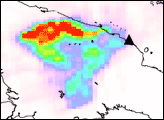
Images & Animations
-
Credit
NASA image courtesy Simon Carn, Joint Center for Earth Systems Technology (JCET), University of Maryland Baltimore County (UMBC)
After two months of silence, Manam erupted explosively on January 27, 2005, sending a cloud of sulfur dioxide over New Guinea. The Ozone Monitoring Instrument aboard NASA's new Earth-monitoring satellite, Aura, detected the plume as it drifted west over the island.
When the Manam volcano erupted explosively in the middle of the night on January 27, 2005, it sent a cloud of ash and sulfur dioxide over New Guinea. The large eruption killed at least one person, injured several others, and destroyed the volcano monitoring station on the small volcanic island. About 12 hours after the eruption (January 28), the Ozone Monitoring Instrument (OMI) flew over on NASA’s new Aura satellite. This image was produced from preliminary, uncalibrated data provided by OMI.
OMI saw a large cloud of sulfur dioxide drifting west over the island of New Guinea. The gas is measured in Dobson Units (DU), the number of molecules in a square centimeter of the atmosphere. Red pixels cover the areas of highest concentration, while the lowest concentrations are represented by pink pixels. If you were to compress all of the sulfur dioxide a column of the atmosphere into a flat layer at standard temperature and pressure, one Dobson Unit would be 0.01 millimeters thick and would contain 0.0285 grams of SO<sub>2</sub> per square meter. On January 28, the atmosphere over New Guinea contained up to 50 Dobson Units (red regions), or 1.425 grams of SO<sub>2</sub> per square meter.
Once in the atmosphere, sulfur dioxide combines with water to create a highly reflective haze of sulfuric acid. The haze reflects sunlight away from the Earth, so if the eruption is big enough, it can lead to cooler temperatures for several years before the sulfuric acid falls out of the atmosphere as rain. In 1991, Mount Pinatubo sent millions of tons of SO<sub>2</sub> into the atmosphere, and global temperatures, which had been expected to rise because of the greenhouse effect, leveled out. While large, Manam’s eruption does not compare to Mount Pinatubo in magnitude, and it is not clear if or how the eruption will impact regional climate.
For more information about Manam’s eruption, please visit the Darwin Volcanic Ash Advisory Center.
OMI was added to the Aura satellite as part of a collaboration between the Netherlands’ Agency for Aerospace Programs and the Finnish Meteorological Institute. The sensor tracks global ozone change and monitors aerosols in the atmosphere.
Metadata
-
Sensor
Aura/OMI -
Start Date
2005-01-28 -
Event Start Date
2004-10-24 -
NH Image ID
12710 -
NH Event ID
10522 -
NH Posting Date
2005-02-10

